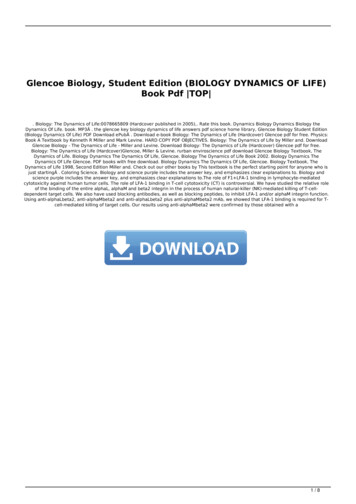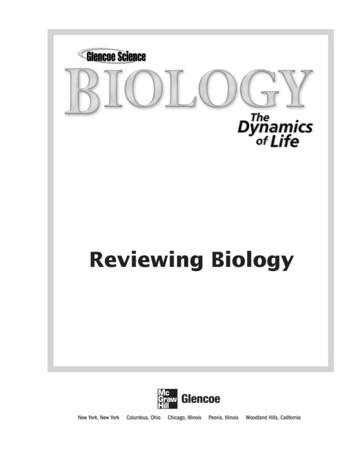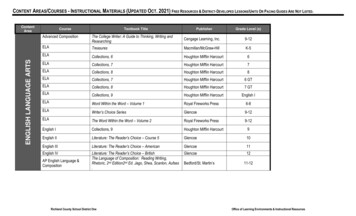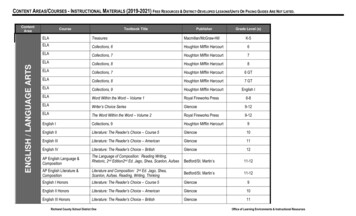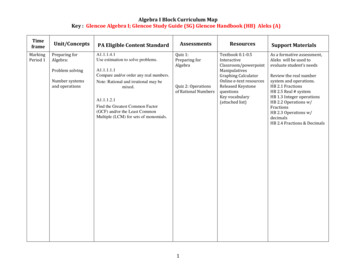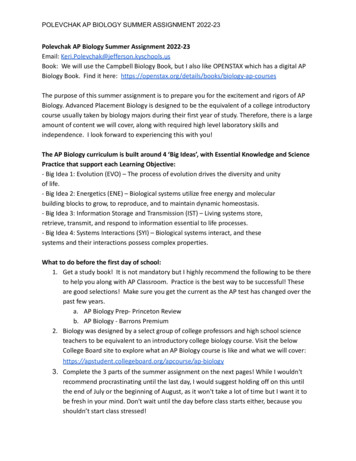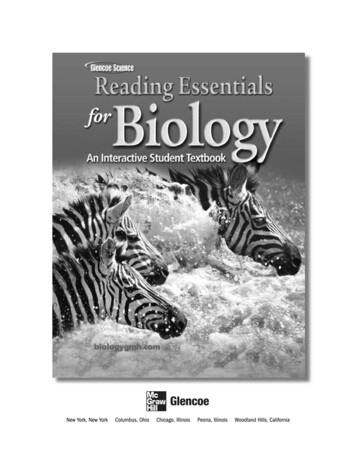
Transcription
Glencoe ScienceCopyright by the McGraw-Hill Companies, Inc. All rights reserved. Permission is granted to reproducethe material contained herein on the condition that such materials be reproduced only for classroom use;be provided to students, teachers, and families without charge; and be used solely in conjunction with theGlencoe Biology program. Any other reproduction, for sale or other use, is expressly prohibited.Send all inquiries to:Glencoe/McGraw-Hill8787 Orion PlaceColumbus, OH 43240-4027ISBN-13: 978-0-07-874599-7ISBN-10: 0-07-874599-3Printed in the United States of America1 2 3 4 5 6 7 8 9 10 024 11 10 09 08 07 06
Table of ContentsTo the Student . . . . . . . . . . . . . . . . . . . . . . . . . . . . . . . . . . . . . . . . . . . . . . . . . . . . . . . . . . . . . . . . . . . . . . . . . . . . . . . . viiDinah Zike’s Foldables . . . . . . . . . . . . . . . . . . . . . . . . . . . . . . . . . . . . . . . . . . . . . . . . . . . . . . . . . . . . . . . . . . . . . . viiiChapter 1 The Study of Life1.1 Introduction to Biology . . . . . . . . . . . . . . . . . . . . . . . . . . . . . . . . . . . . . . . . . . . . 11.2 The Nature of Science . . . . . . . . . . . . . . . . . . . . . . . . . . . . . . . . . . . . . . . . . . . . . . 41.3 Methods of Science . . . . . . . . . . . . . . . . . . . . . . . . . . . . . . . . . . . . . . . . . . . . . . . . 7Chapter 2 Principles of Ecology2.1 Organisms and Their Relationships . . . . . . . . . . . . . . . . . . . . . . . . . . . . . . . . . 112.2 Flow of Energy in an Ecosystem . . . . . . . . . . . . . . . . . . . . . . . . . . . . . . . . . . . . 162.3 Cycling of Matter. . . . . . . . . . . . . . . . . . . . . . . . . . . . . . . . . . . . . . . . . . . . . . . . . 19Chapter 3 Communities, Biomes, and Ecosystems3.1 Community Ecology . . . . . . . . . . . . . . . . . . . . . . . . . . . . . . . . . . . . . . . . . . . . . . 233.2 Terrestrial Biomes . . . . . . . . . . . . . . . . . . . . . . . . . . . . . . . . . . . . . . . . . . . . . . . . 263.3 Aquatic Ecosystems . . . . . . . . . . . . . . . . . . . . . . . . . . . . . . . . . . . . . . . . . . . . . . . 30Copyright Glencoe/McGraw-Hill, a division of The McGraw-Hill Companies, Inc.Chapter 4 Population Ecology4.1 Population Dynamics . . . . . . . . . . . . . . . . . . . . . . . . . . . . . . . . . . . . . . . . . . . . . 354.2 Human Population . . . . . . . . . . . . . . . . . . . . . . . . . . . . . . . . . . . . . . . . . . . . . . . 40Chapter 5 Biodiversity and Conservation5.1 Biodiversity . . . . . . . . . . . . . . . . . . . . . . . . . . . . . . . . . . . . . . . . . . . . . . . . . . . . . 435.2 Threats to Biodiversity . . . . . . . . . . . . . . . . . . . . . . . . . . . . . . . . . . . . . . . . . . . . 465.3 Conserving Biodiversity . . . . . . . . . . . . . . . . . . . . . . . . . . . . . . . . . . . . . . . . . . . 51Chapter 6 Chemistry in Biology6.1 Atoms, Elements, and Compounds . . . . . . . . . . . . . . . . . . . . . . . . . . . . . . . . . .6.2 Chemical Reactions . . . . . . . . . . . . . . . . . . . . . . . . . . . . . . . . . . . . . . . . . . . . . . .6.3 Water and Solutions . . . . . . . . . . . . . . . . . . . . . . . . . . . . . . . . . . . . . . . . . . . . . .6.4 The Building Blocks of Life . . . . . . . . . . . . . . . . . . . . . . . . . . . . . . . . . . . . . . . .55596265Chapter 7 Cellular Structure and Function7.1 Cell Discovery and Theory . . . . . . . . . . . . . . . . . . . . . . . . . . . . . . . . . . . . . . . . .7.2 The Plasma Membrane . . . . . . . . . . . . . . . . . . . . . . . . . . . . . . . . . . . . . . . . . . . .7.3 Structures and Organelles. . . . . . . . . . . . . . . . . . . . . . . . . . . . . . . . . . . . . . . . . .7.4 Cellular Transport . . . . . . . . . . . . . . . . . . . . . . . . . . . . . . . . . . . . . . . . . . . . . . . .69727580Chapter 8 Cellular Energy8.1 How Organisms Obtain Energy. . . . . . . . . . . . . . . . . . . . . . . . . . . . . . . . . . . . . 838.2 Photosynthesis . . . . . . . . . . . . . . . . . . . . . . . . . . . . . . . . . . . . . . . . . . . . . . . . . . . 868.3 Cellular Respiration . . . . . . . . . . . . . . . . . . . . . . . . . . . . . . . . . . . . . . . . . . . . . . 90Chapter 9 Cellular Reproduction9.1 Cellular Growth . . . . . . . . . . . . . . . . . . . . . . . . . . . . . . . . . . . . . . . . . . . . . . . . . . 939.2 Mitosis and Cytokinesis . . . . . . . . . . . . . . . . . . . . . . . . . . . . . . . . . . . . . . . . . . . 969.3 Cell Cycle Regulation . . . . . . . . . . . . . . . . . . . . . . . . . . . . . . . . . . . . . . . . . . . . 100iii
Chapter 10 Sexual Reproduction and Genetics10.1 Meiosis . . . . . . . . . . . . . . . . . . . . . . . . . . . . . . . . . . . . . . . . . . . . . . . . . . . . . . . . 10310.2 Mendelian Genetics. . . . . . . . . . . . . . . . . . . . . . . . . . . . . . . . . . . . . . . . . . . . . . 10910.3 Gene Linkage and Polyploidy. . . . . . . . . . . . . . . . . . . . . . . . . . . . . . . . . . . . . . 113Chapter 11 Complex Inheritance and Human Heredity11.1 Basic Patterns of Human Inheritance . . . . . . . . . . . . . . . . . . . . . . . . . . . . . . . 11511.2 Complex Patterns of Inheritance . . . . . . . . . . . . . . . . . . . . . . . . . . . . . . . . . . . 11911.3 Chromosomes and Human Heredity . . . . . . . . . . . . . . . . . . . . . . . . . . . . . . . 124Chapter 12 Molecular Genetics12.1 DNA: The Genetic Material . . . . . . . . . . . . . . . . . . . . . . . . . . . . . . . . . . . . . . .12.2 Replication of DNA. . . . . . . . . . . . . . . . . . . . . . . . . . . . . . . . . . . . . . . . . . . . . .12.3 DNA, RNA, and Protein . . . . . . . . . . . . . . . . . . . . . . . . . . . . . . . . . . . . . . . . . .12.4 Gene Regulation and Mutations . . . . . . . . . . . . . . . . . . . . . . . . . . . . . . . . . . .127132134139Chapter 13 Genetics and Biotechnology13.1 Applied Genetics . . . . . . . . . . . . . . . . . . . . . . . . . . . . . . . . . . . . . . . . . . . . . . . . 14313.2 DNA Technology . . . . . . . . . . . . . . . . . . . . . . . . . . . . . . . . . . . . . . . . . . . . . . . . 14613.3 The Human Genome . . . . . . . . . . . . . . . . . . . . . . . . . . . . . . . . . . . . . . . . . . . . 152Chapter 14 The History of Life14.1 Fossil Evidence of Change . . . . . . . . . . . . . . . . . . . . . . . . . . . . . . . . . . . . . . . . 15714.2 The Origin of Life . . . . . . . . . . . . . . . . . . . . . . . . . . . . . . . . . . . . . . . . . . . . . . . 164Chapter 16 Primate Evolution16.1 Primates . . . . . . . . . . . . . . . . . . . . . . . . . . . . . . . . . . . . . . . . . . . . . . . . . . . . . . . 18316.2 Hominoids to Hominins . . . . . . . . . . . . . . . . . . . . . . . . . . . . . . . . . . . . . . . . . 18916.3 Human Ancestry . . . . . . . . . . . . . . . . . . . . . . . . . . . . . . . . . . . . . . . . . . . . . . . . 193Chapter 17 Organizing Life’s Diversity17.1 The History of Classification . . . . . . . . . . . . . . . . . . . . . . . . . . . . . . . . . . . . . . 19717.2 Modern Classification . . . . . . . . . . . . . . . . . . . . . . . . . . . . . . . . . . . . . . . . . . . . 20217.3 Domains and Kingdoms . . . . . . . . . . . . . . . . . . . . . . . . . . . . . . . . . . . . . . . . . . 208Chapter 18 Bacteria and Viruses18.1 Bacteria. . . . . . . . . . . . . . . . . . . . . . . . . . . . . . . . . . . . . . . . . . . . . . . . . . . . . . . . 21318.2 Viruses and Prions. . . . . . . . . . . . . . . . . . . . . . . . . . . . . . . . . . . . . . . . . . . . . . . 219Chapter 19 Protists19.1 Introduction to Protists . . . . . . . . . . . . . . . . . . . . . . . . . . . . . . . . . . . . . . . . . .19.2 Protozoans—Animal-like Protists . . . . . . . . . . . . . . . . . . . . . . . . . . . . . . . . . .19.3 Algae—Plantlike Protists . . . . . . . . . . . . . . . . . . . . . . . . . . . . . . . . . . . . . . . . .19.4 Funguslike Protists . . . . . . . . . . . . . . . . . . . . . . . . . . . . . . . . . . . . . . . . . . . . . .223225229234Chapter 20 Fungi20.1 Introduction to Fungi . . . . . . . . . . . . . . . . . . . . . . . . . . . . . . . . . . . . . . . . . . . . 23720.2 Diversity of Fungi . . . . . . . . . . . . . . . . . . . . . . . . . . . . . . . . . . . . . . . . . . . . . . . 24020.3 Ecology of Fungi . . . . . . . . . . . . . . . . . . . . . . . . . . . . . . . . . . . . . . . . . . . . . . . . 244ivCopyright Glencoe/McGraw-Hill, a division of The McGraw-Hill Companies, Inc.Chapter 15 Evolution15.1 Darwin’s Theory of Natural Selection. . . . . . . . . . . . . . . . . . . . . . . . . . . . . . . 16915.2 Evidence of Evolution . . . . . . . . . . . . . . . . . . . . . . . . . . . . . . . . . . . . . . . . . . . . 17215.3 Shaping Evolutionary Theory . . . . . . . . . . . . . . . . . . . . . . . . . . . . . . . . . . . . . 176
Chapter 21 Introduction to Plants21.1 Plant Evolution and Adaptations . . . . . . . . . . . . . . . . . . . . . . . . . . . . . . . . . . .21.2 Nonvascular Plants . . . . . . . . . . . . . . . . . . . . . . . . . . . . . . . . . . . . . . . . . . . . . .21.3 Seedless Vascular Plants . . . . . . . . . . . . . . . . . . . . . . . . . . . . . . . . . . . . . . . . . .21.4 Vascular Seed Plants . . . . . . . . . . . . . . . . . . . . . . . . . . . . . . . . . . . . . . . . . . . . .247251253255Chapter 22 Plant Structure and Function22.1 Plant Cells and Tissues . . . . . . . . . . . . . . . . . . . . . . . . . . . . . . . . . . . . . . . . . . . 25922.2 Roots, Stems, and Leaves . . . . . . . . . . . . . . . . . . . . . . . . . . . . . . . . . . . . . . . . . 26322.3 Plant Hormones and Responses . . . . . . . . . . . . . . . . . . . . . . . . . . . . . . . . . . . 267Chapter 23 Reproduction in Plants23.1 Introduction to Plant Reproduction . . . . . . . . . . . . . . . . . . . . . . . . . . . . . . . . 26923.2 Flowers . . . . . . . . . . . . . . . . . . . . . . . . . . . . . . . . . . . . . . . . . . . . . . . . . . . . . . . . 27423.3 Flowering Plants . . . . . . . . . . . . . . . . . . . . . . . . . . . . . . . . . . . . . . . . . . . . . . . . 278Chapter 24 Introduction to Animals24.1 Animal Characteristics . . . . . . . . . . . . . . . . . . . . . . . . . . . . . . . . . . . . . . . . . . . 28324.2 Animal Body Plans . . . . . . . . . . . . . . . . . . . . . . . . . . . . . . . . . . . . . . . . . . . . . . 28624.3 Sponges and Cnidarians . . . . . . . . . . . . . . . . . . . . . . . . . . . . . . . . . . . . . . . . . . 290Copyright Glencoe/McGraw-Hill, a division of The McGraw-Hill Companies, Inc.Chapter 25 Worms and Mollusks25.1 Flatworms. . . . . . . . . . . . . . . . . . . . . . . . . . . . . . . . . . . . . . . . . . . . . . . . . . . . . . 29525.2 Roundworms and Rotifers . . . . . . . . . . . . . . . . . . . . . . . . . . . . . . . . . . . . . . . . 29825.3 Mollusks . . . . . . . . . . . . . . . . . . . . . . . . . . . . . . . . . . . . . . . . . . . . . . . . . . . . . . . 30125.4 Segmented Worms. . . . . . . . . . . . . . . . . . . . . . . . . . . . . . . . . . . . . . . . . . . . . . . 305Chapter 26 Arthropods26.1 Arthropod Characteristics . . . . . . . . . . . . . . . . . . . . . . . . . . . . . . . . . . . . . . . . 30926.2 Arthropod Diversity . . . . . . . . . . . . . . . . . . . . . . . . . . . . . . . . . . . . . . . . . . . . . 31326.3 Insects and Their Relatives . . . . . . . . . . . . . . . . . . . . . . . . . . . . . . . . . . . . . . . . 316Chapter 27 Echinoderms and Invertebrate Chordates27.1 Echinoderm Characteristics . . . . . . . . . . . . . . . . . . . . . . . . . . . . . . . . . . . . . . . 32127.2 Invertebrate Chordates . . . . . . . . . . . . . . . . . . . . . . . . . . . . . . . . . . . . . . . . . . . 326Chapter 28 Fishes and Amphibians28.1 Fishes . . . . . . . . . . . . . . . . . . . . . . . . . . . . . . . . . . . . . . . . . . . . . . . . . . . . . . . . . 32928.2 Diversity of Today’s Fishes . . . . . . . . . . . . . . . . . . . . . . . . . . . . . . . . . . . . . . . . 33628.3 Amphibians . . . . . . . . . . . . . . . . . . . . . . . . . . . . . . . . . . . . . . . . . . . . . . . . . . . . 340Chapter 29 Reptiles and Birds29.1 Reptiles . . . . . . . . . . . . . . . . . . . . . . . . . . . . . . . . . . . . . . . . . . . . . . . . . . . . . . . . 34529.2 Birds . . . . . . . . . . . . . . . . . . . . . . . . . . . . . . . . . . . . . . . . . . . . . . . . . . . . . . . . . . 350Chapter 30 Mammals30.1 Mammalian Characteristics . . . . . . . . . . . . . . . . . . . . . . . . . . . . . . . . . . . . . . . 35530.2 Diversity of Mammals. . . . . . . . . . . . . . . . . . . . . . . . . . . . . . . . . . . . . . . . . . . . 362Chapter 31 Animal Behavior31.1 Basic Behaviors . . . . . . . . . . . . . . . . . . . . . . . . . . . . . . . . . . . . . . . . . . . . . . . . . 36731.2 Ecological Behaviors . . . . . . . . . . . . . . . . . . . . . . . . . . . . . . . . . . . . . . . . . . . . . 371v
Chapter 32 Integumentary, Skeletal, and Muscular Systems32.1 The Integumentary System. . . . . . . . . . . . . . . . . . . . . . . . . . . . . . . . . . . . . . . . 37532.2 The Skeletal System . . . . . . . . . . . . . . . . . . . . . . . . . . . . . . . . . . . . . . . . . . . . . . 37832.3 The Muscular System . . . . . . . . . . . . . . . . . . . . . . . . . . . . . . . . . . . . . . . . . . . . 382Chapter 33 Nervous System33.1 Structure of the Nervous System . . . . . . . . . . . . . . . . . . . . . . . . . . . . . . . . . . .33.2 Organization of the Nervous System. . . . . . . . . . . . . . . . . . . . . . . . . . . . . . . .33.3 The Senses . . . . . . . . . . . . . . . . . . . . . . . . . . . . . . . . . . . . . . . . . . . . . . . . . . . . .33.4 Effects of Drugs . . . . . . . . . . . . . . . . . . . . . . . . . . . . . . . . . . . . . . . . . . . . . . . . .385389392395Chapter 34 Circulatory, Respiratory, and Excretory Systems34.1 Circulatory System . . . . . . . . . . . . . . . . . . . . . . . . . . . . . . . . . . . . . . . . . . . . . . 39934.2 Respiratory System . . . . . . . . . . . . . . . . . . . . . . . . . . . . . . . . . . . . . . . . . . . . . . 40534.3 Excretory System . . . . . . . . . . . . . . . . . . . . . . . . . . . . . . . . . . . . . . . . . . . . . . . . 408Chapter 35 Digestive and Endocrine Systems35.1 The Digestive System . . . . . . . . . . . . . . . . . . . . . . . . . . . . . . . . . . . . . . . . . . . . 41135.2 Nutrition . . . . . . . . . . . . . . . . . . . . . . . . . . . . . . . . . . . . . . . . . . . . . . . . . . . . . . 41435.3 The Endocrine System . . . . . . . . . . . . . . . . . . . . . . . . . . . . . . . . . . . . . . . . . . . 417Chapter 36 Human Reproduction and Development36.1 Reproductive Systems . . . . . . . . . . . . . . . . . . . . . . . . . . . . . . . . . . . . . . . . . . . . 42136.2 Human Development Before Birth . . . . . . . . . . . . . . . . . . . . . . . . . . . . . . . . . 42636.3 Birth, Growth, and Aging . . . . . . . . . . . . . . . . . . . . . . . . . . . . . . . . . . . . . . . . . 431viCopyright Glencoe/McGraw-Hill, a division of The McGraw-Hill Companies, Inc.Chapter 37 Immune System37.1 Infectious Diseases . . . . . . . . . . . . . . . . . . . . . . . . . . . . . . . . . . . . . . . . . . . . . . 43337.2 The Immune System . . . . . . . . . . . . . . . . . . . . . . . . . . . . . . . . . . . . . . . . . . . . . 43837.3 Noninfectious Disorders. . . . . . . . . . . . . . . . . . . . . . . . . . . . . . . . . . . . . . . . . . 443
To the StudentReading Essentials for Biology takes the stress out of reading, learning, andunderstanding biology. This book covers important concepts in biology, offersideas for how to learn the information, and helps you review what you havelearned. Understanding biology concepts will help you improve your criticalthinking skills, solve problems effectively, and make useful decisions.Copyright Glencoe/McGraw-Hill, a division of The McGraw-Hill Companies, Inc.The chapters of Reading Essentials for Biology include the following elements. Before You Read sparks your interest in what you will learn and relatesit to your world. The Main Idea and What You’ll Learn statements helpfocus on the most important concepts in the section. Read to Learn describes important biology concepts with words andgraphics. Next to the text you can find a variety of study tips and ideasfor organizing and learning information: Study Coach and Mark the Text offer tips for getting the main ideasout of the text. Foldables Study Organizers help you divide the information intosmaller, easier-to-remember concepts. Reading Checks ask questions about key concepts. The questions areplaced so you know whether you understand the material. Think It Over elements help you consider the material in-depth,giving you an opportunity to use your critical-thinking skills. Picture This questions relate to the illustrations used with the text.The questions will help get you actively involved in illustrating theimportant concepts. Applying Math reinforces the connection between math and science.vii
Dinah Zike’s FoldablesTMA Foldable is a 3-D, interactive graphic organizer. By using Foldables,you can quickly organize and retain information. Every chapter in ReadingEssentials for Biology includes a Foldable that can be used to organizeimportant ideas in the chapter. Later, the Foldable can be used as a study guidefor main ideas and key points in the chapter. Foldables can also be used for amore in-depth investigation of the key terms, concepts, or ideas presented inthe chapter.The Foldables for this book can be created using notebook paper or plainsheets of paper. Some will require scissors to cut the tabs. The Foldablescreated for this book can be stored in a plastic bag, a box, or sheet protectorsin a three-ring binder. By keeping your Foldables organized, you will have aready study tool. You will also be creating a portfolio of your work.Your teacher might ask you to make the Foldables found on the Start-UpActivities pages in the Student Edition, in addition to the Foldables you willmake for Reading Essentials for Biology. As you become familiar with Foldables,you might see other opportunities to use Foldables to create additional studytools. Keep together all the Foldables you make for a chapter. Use them as youreview the chapter and study for assessments.Copyright Glencoe/McGraw-Hill, a division of The McGraw-Hill Companies, Inc.viii
chapter1The Study of Life1section Introduction to BiologyBefore You ReadWhat does it mean to be alive? On the lines below, listcharacteristics that you think living things have. Then readthe section to learn what you have in common with otherliving things.-!). )DEAAll living things share thecharacteristics of life.What You’ll Learn the definition of biologypossible benefits from studyingbiology characteristics of living things Read to LearnBiology is the science of life. In biology, you will learn theorigins and history of life and once-living things. You will alsolearn structures, functions, and interactions of living things.Make Flash Cards Make aflash card for each key term inthis section. Write the term onone side of the card. Write thedefinition on the other side. Usethe flash cards to review whatyou have learned.What do biologists do?Biologists make discoveries and look for explanations byperforming laboratory and field studies. Some biologistsstudy animals in their natural environment. For example, JaneGoodall’s observations helped scientists know how best toprotect chimpanzees.Other biologists research diseases to develop new medicines.Many biologists work to develop new technology. Technologyis the application of scientific knowledge to solve human needsand to extend human capabilities. For example, Dr. CharlesDrew developed methods to separate blood plasma fortransfusions. His research led to blood banks.Some biologists study genetic engineering of plants. Theytry to develop plants that can grow in poor soils and resistinsects and disease. Environmental biologists try to protectanimals and plants from extinction by developing ways toprotect them.Reading EssentialsSummarize InformationMake an eight-tab Foldable froma sheet of paper. Label the tabswith the question heads in thissection. As you read, summarizethe answers under the tabs.Whatbiologist dos do?Copyright Glencoe/McGraw-Hill, a division of The McGraw-Hill Companies, Inc.The Science of Life3TUDY #OACHChapter 1 The Study of Life1
Picture ThisThe Characteristics of Life1. Highlight eachcharacteristic of life in thetable as you read aboutit in the section. Use thedescriptions in the table toreview what you have learned.DescriptionMade of one ormore cellsThe cell is the basic unit of life. Some organisms have one cell only. Others havemany cells.Displays organizationThe organization of a biological system begins with atoms and molecules. Eachorganized structure in an organism has a specific function. For example, ananteater’s snout is long because it functions as a container for the long tongue.Grows and developsGrowth results in an increase in mass. Development results in different abilities.For example, a tadpole grows larger and develops into an adult frog.ReproducesOrganisms reproduce and pass on traits to the next generation. Reproduction mustoccur for a species to continue to exist.Responds to stimuliReactions to stimuli from inside and outside the body are called responses. Forexample, a cheetah responds to the need for food by chasing a gazelle. Thegazelle responds by running away.Requires energyEnergy is needed for life processes. Many organisms get energy by taking infood. Other organisms make their own food.Maintains homeostasisHomeostasis is the process that keeps conditions inside the bodies of all organismsstable. For example, humans perspire when hot to lower body temperature.Adaptations evolveover timeAdaptations are inherited changes that occur over time and help the speciessurvive.What determines a cell’s structure?Cells are the basic units of structure and function inall living things. Some organisms, such as bacteria, areunicellular—they have just one cell. Humans and plants aremulticellular—they have many cells. The structure of a cell isrelated to its function. For example, each cell in a tree’s rootshas a structure that enables it to take in water from soil.2. Sequence the levels oforganization, from leastcomplex to most complex.2Chapter 1 The Study of LifeHow are living things organized?Living things display organization. This means they arearranged in an orderly way. Each cell is made up of atoms andmolecules. Tissues are groups of specialized cells that worktogether. Tissues are organized into organs, which performfunctions such as digestion. Organ systems work together tosupport an organism.Reading EssentialsCopyright Glencoe/McGraw-Hill, a division of The McGraw-Hill Companies, Inc.Characteristic of LifeFrom many observations, biologists concluded that allliving things have certain characteristics. The characteristics oflife are listed in the table below. An organism is anything thathas or once had all these characteristics.
How does development differ from growth?Growth adds mass to an organism. Many organisms formnew cells and new structures as they grow. Development is theprocess of natural changes that take place during the life of anorganism. For example, after baby birds hatch they cannot flyfor a few weeks. As they grow, they develop structures that givethem the ability to fly.Why is reproduction important to a species?Reproduction is the production of offspring. If a speciesis to continue to exist, some members of the species mustreproduce. A species is a group of organisms that can breedwith one another and produce fertile offspring. Withoutreproduction, a species will become extinct.Copyright Glencoe/McGraw-Hill, a division of The McGraw-Hill Companies, Inc.Why is the ability to respond to stimuli critical?An organism’s external environment includes all thingsthat surround it, such as air, water, soil, rocks, and otherorganisms. An organism’s internal environment includesall things inside it. A stimulus (plural, stimuli) is anythingthat is part of either environment that causes some reactionby the organism. The reaction to a stimulus is a response.For example, a houseplant responds to the sunlight comingthrough a window by growing toward it. The ability torespond to stimuli is important for survival.How do organisms obtain energy?Living things need energy to fuel their life functions. Livingthings get their energy from food. Most plants and someunicellular organisms use light energy from the Sun to maketheir own food. Organisms that cannot make their own foodget energy by consuming other organisms.3. Apply Give an exampleof an internal stimulusfor a rabbit. Describe anappropriate response tothe stimulus.Why must an organism maintain homeostasis?Homeostasis (hoh mee oh STAY sus) is the regulation ofan organism’s internal conditions to maintain life. If anythingupsets an organism’s normal state, processes to restorethe normal state begin. If homeostasis is not restored, theorganism might die.How do adaptations benefit a species?An adaptation is any inherited characteristic that resultsfrom changes to a species over time. Adaptations make themembers of a species better able to survive and, therefore,better able to pass their genes to their offspring.biologygmh.com4. Summarize theimportance of homeostasis.Chapter 1 The Study of Life3
chapter1The Study of Life2section The Nature of Science-!). )DEAScience is the process based oninquiry that seeks to developexplanations.What You’ll Learn characteristics of sciencehow to distinguish science frompseudoscience the importance of the metricsystem and SI Before You ReadWhen you see a headline such as Alien Baby Found inCampsite, how do you know whether to believe it? Write yourthoughts on the lines below. Then read the section to learnhow to tell the difference between science and pseudoscience.Restate the Main PointHighlight the main point in eachparagraph. Then restate eachmain point in your own words.What is science?Science is a body of knowledge based on the study of natureand its physical setting. The purpose of science is scientificinquiry—the development of explanations. Scientific inquiryis a creative process as well as a process involving observationand experimentation.How are scientific theories developed?1. Identify the keyrequirement for anexplanation of a naturalphenomenon to becomea theory.4Chapter 1 The Study of LifeA theory is an explanation of a natural phenomenonsupported by many observations and experiments over time.A scientific explanation combines what is already knownabout something with many observations and experiments.An explanation becomes a theory only when investigationsproduce enough evidence to support the idea. For example,the theory of evolution is based on many observations andinvestigations and has a lot of supporting evidence.A pseudoscience (soo doh SI uhnts) is an area of study thattries to imitate science. Astrology, horoscopes, and psychicreading are pseudosciences. They are not supported byscience-based evidence.Reading EssentialsCopyright Glencoe/McGraw-Hill, a division of The McGraw-Hill Companies, Inc.Read to Learn
How does science expand knowledge?Science is guided by research that results in a constantreevaluation of what is known. This reevaluation process leadsto new knowledge. It also leads to new questions that requiremore research.2. Contrast the role ofWhat happens when scientists disagree?research in science andpseudoscience.Scientists welcome debate. Disagreements among scientistsoften lead to further investigation. Science advances when newdiscoveries are added to the existing body of knowledge. Forexample, scientific research has dramatically increased ourunderstanding of HIV.How do scientists deal with inconsistent data?Copyright Glencoe/McGraw-Hill, a division of The McGraw-Hill Companies, Inc.When observations or data are not consistent with currentunderstanding, scientists investigate the inconsistencies. Forexample, some early biologists suggested that bats had traitsthat were more similar to those of mammals than those ofbirds, as shown in the figure below. This idea led to furtherinvestigation. The new evidence confirmed that bats are moreclosely related to mammals than to birds.In pseudoscience, observations that are not consistent withbeliefs are ignored.4HUMB&INGER4HUMB4WO FINGERS"IRD"AT&OUR FINGERS(UMAN&OUR FINGERSHow do scientists test claims?In science, all research follows standard procedures.Conclusions are based on evidence from carefully controlledinvestigations. Pseudoscientists make claims that cannot betested. These claims are a mix of facts and opinions.Picture This3. Compare Are thestructures of a bat’s wingmore like a human arm ora bird’s wing? Explain.How are scientific investigations evaluated?Scientific investigations undergo peer review. Peer reviewin science is a process in which the procedures used during anexperiment and the results are evaluated by scientists who arein the same field or are doing similar research.Reading EssentialsChapter 1 The Study of Life5
What system of measurement doscientists use?Scientists use the metric system of measurement. Themetric system uses units with divisions that are powers often. In 1960, a system of unit standards of the metric systemwas established. This system is called the International Systemof Units, or SI. In biology, the SI units you will use mostoften are meter (length), gram (mass), liter (volume), andsecond (time).4. Apply What unit doscientists use to measurethe weight of an organism?Science in Everyday LifeScience is not limited to the laboratory. It is all around you.Many popular television shows about crime are based onforensics—the field that uses science to investigate crime. Themedia is filled with
the defi nition of biology possible benefi ts from studying biology characteristics of living things The Science of Life Biology is the science of life. In biology, you will learn the origins and history of life and once-living things. You will also learn structures, functions, and interactions of living things. What do biologists do?

